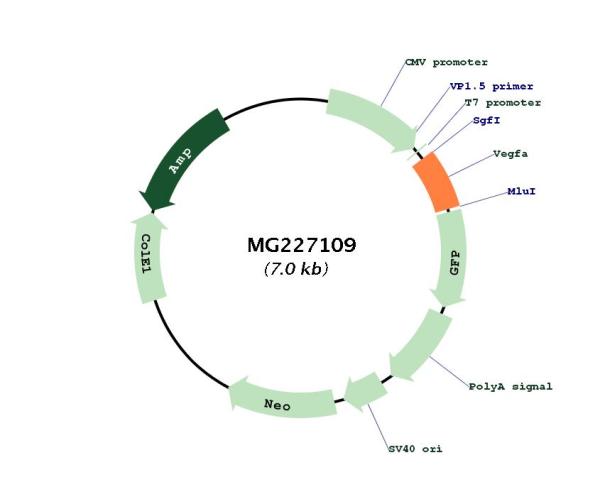Vegfa (NM_001110266) Mouse Tagged ORF Clone
CAT#: MG227109
- TrueORF®
Vegfa (tGFP-tagged) - Mouse vascular endothelial growth factor A (Vegfa) transcript variant 4, (10ug)
ORF Plasmid: DDK
Lentiviral Particles: DDK w/ Puro mGFP w/ Puro
"NM_001110266" in other vectors (4)
Specifications
| Product Data | |
| Type | Mouse Tagged ORF Clone |
| Tag | TurboGFP |
| Symbol | Vegfa |
| Synonyms | V; Veg; Vegf; VEGF12; VEGF16; VEGF18; Vpf |
| Vector | pCMV6-AC-GFP |
| E. coli Selection | Ampicillin (100 ug/mL) |
| Mammalian Cell Selection | Neomycin |
| Sequence Data |
>MG227109 representing NM_001110266
Red=Cloning site Blue=ORF Green=Tags(s) TTTTGTAATACGACTCACTATAGGGCGGCCGGGAATTCGTCGACTGGATCCGGTACCGAGGAGATCTGCC GCCGCGATCGCC ATGGCAGGAGCCCCGGGGTGTCCCATAGGGGTATGGCTGGCTGGGTCACTAACCACTGTGATCTGCTCCC TCCCTCTACAGATCATGCGGATCAAACCTCACCAAAGCCAGCACATAGGAGAGATGAGCTTCCTACAGCA CAGCAGATGTGAATGCAGACCAAAGAAAGACAGAACAAAGCCAGAAAAAAAATCAGTTCGAGGAAAGGGA AAGGGTCAAAAACGAAAGCGCAAGAAATCCCGGTTTAAATCCTGGAGCGTTCACTGTGAGCCTTGTTCAG AGCGGAGAAAGCATTTGTTTGTCCAAGATCCGCAGACGTGTAAATGTTCCTGCAAAAACACAGACTCGCG TTGCAAGGCGAGGCAGCTTGAGTTAAACGAACGTACTTGCAGATGTGACAAGCCAAGGCGG ACGCGTACGCGGCCGCTCGAG - GFP Tag - GTTTAA >MG227109 representing NM_001110266
Red=Cloning site Green=Tags(s) MAGAPGCPIGVWLAGSLTTVICSLPLQIMRIKPHQSQHIGEMSFLQHSRCECRPKKDRTKPEKKSVRGKG KGQKRKRKKSRFKSWSVHCEPCSERRKHLFVQDPQTCKCSCKNTDSRCKARQLELNERTCRCDKPRR TRTRPLE - GFP Tag - V |
| Restriction Sites |
SgfI-MluI
Cloning Scheme for this gene
Plasmid Map

|
| ACCN | NM_001110266 |
| ORF Size | 411 bp |
| OTI Disclaimer | The molecular sequence of this clone aligns with the gene accession number as a point of reference only. However, individual transcript sequences of the same gene can differ through naturally occurring variations (e.g. polymorphisms), each with its own valid existence. This clone is substantially in agreement with the reference, but a complete review of all prevailing variants is recommended prior to use. More info |
| OTI Annotation | This clone was engineered to express the complete ORF with an expression tag. Expression varies depending on the nature of the gene. |
| Product Components | The ORF clone is ion-exchange column purified and shipped in a 2D barcoded Matrix tube containing 10ug of transfection-ready, dried plasmid DNA (reconstitute with 100 ul of water). |
| Reconstitution | 1. Centrifuge at 5,000xg for 5min. 2. Carefully open the tube and add 100ul of sterile water to dissolve the DNA. 3. Close the tube and incubate for 10 minutes at room temperature. 4. Briefly vortex the tube and then do a quick spin (less than 5000xg) to concentrate the liquid at the bottom. 5. Store the suspended plasmid at -20°C. The DNA is stable for at least one year from date of shipping when stored at -20°C. |
| Reference Data | |
| RefSeq | NM_001110266.1, NP_001103736.1 |
| RefSeq Size | 2857 bp |
| RefSeq ORF | 414 bp |
| Locus ID | 22339 |
| UniProt ID | Q00731 |
| Cytogenetics | 17 22.79 cM |
| Gene Summary | This gene is a member of the PDGF/VEGF growth factor family. It encodes a heparin-binding protein, which exists as a disulfide-linked homodimer. This growth factor induces proliferation and migration of vascular endothelial cells, and is essential for both physiological and pathological angiogenesis. Disruption of this gene in mice resulted in abnormal embryonic blood vessel formation. This gene is upregulated in many known tumors and its expression is correlated with tumor stage and progression. Alternatively spliced transcript variants encoding different isoforms have been found for this gene. There is also evidence for alternative translation initiation from upstream non-AUG (CUG) codons resulting in additional isoforms. A recent study showed that a C-terminally extended isoform is produced by use of an alternative in-frame translation termination codon via a stop codon readthrough mechanism, and that this isoform is antiangiogenic. Expression of some isoforms derived from the AUG start codon is regulated by a small upstream open reading frame, which is located within an internal ribosome entry site.[provided by RefSeq, Nov 2015] |
Documents
| Product Manuals |
| FAQs |
| SDS |
Resources
Other Versions
| SKU | Description | Size | Price |
|---|---|---|---|
| MC209633 | Vegfa (untagged) - Mouse vascular endothelial growth factor A (Vegfa), transcript variant 4, (10ug) |
USD 165.00 |
|
| MR227109 | Vegfa (Myc-DDK-tagged) - Mouse vascular endothelial growth factor A (Vegfa), transcript variant 4 |
USD 165.00 |
|
| MR227109L3 | Lenti ORF clone of Vegfa (Myc-DDK-tagged) - Mouse vascular endothelial growth factor A (Vegfa), transcript variant 4 |
USD 465.00 |
|
| MR227109L4 | Lenti ORF clone of Vegfa (mGFP-tagged) - Mouse vascular endothelial growth factor A (Vegfa), transcript variant 4 |
USD 465.00 |
{0} Product Review(s)
Be the first one to submit a review






























































































































































































































































 Germany
Germany
 Japan
Japan
 United Kingdom
United Kingdom
 China
China

